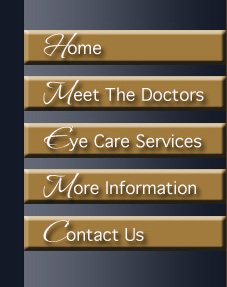Eye Care Services
>>> Optical Dispensary and Contact Lenses | Insurance Plans
New Frame List
Sample of lines we carry:
- Nike
- Vera Bradley
- Nautica
- Flexible Frames – Flexon
- Dolce & Gabbana
- Ray Ban
- Bebe
- Juicy
- Gucci
- Brooks Brothers
- Anne Klein
- LuLu Guinness
- Michael Kors
- Kenneth Cole
- Banana Republic
- Converse
- Guess
- Izod
- Vogue
- EZ-Clip
- DKNY
- Adrienne Vittadini
- Elle
- Puma
- Jones New York
- Marc Jacobs
- BCBG
- and many more. If you don’t see the brand you like, just call!
Lens Types
Single Vision: Single vision lenses provide correction with only one focal point. These are typically worn either for driving or reading, and can often be used for both activities by people under 40.
Bifocals: Standard bifocals have a visible line and provide two fields of vision, distance and near. There is no special area for midrange (computer) viewing.
Trifocals: These lenses have 2 lines and provide three fields of view; distance, intermediate/computer, and near.
Progressive: Progressive addition lenses have no tell-tale lines, so no one has to know you're wearing "bifocals". They provide a continuous, gradual change in power throughout the lens. Distance (driving) vision is in the top section, shading down to full reading power at the bottom. These lenses provide the most natural vision for anyone who requires any type of multifocal correction, and are the most cosmetically appealing.
Lens Materials
Polycarbonate Lenses: Polycarbonate is the strongest, safest, lightest and usually the thinnest material available. It is more impact resistant than any other material and includes ultraviolet protection and scratch resistant coating.
Plastic Lenses: Conventional plastic is both lighter and more impact resistant than glass. They are the most economical and work well for lower power prescriptions. High-index plastic lenses offer those with higher perscriptions a thinner, lighter, more cosmetic design.
Glass: Glass is the heaviest and most breakable of the lens choices. It is more scratch resistant, but is potentially dangerous. As you might guess it’s not very popular and is not available at some optical labs.
Lens Coatings and Options:
Anti-Reflective: Anti-Reflective lenses are much like the lenses used on very fine cameras to reduce glare and reflected light. A good anti-reflective coating allows more light to be transmitted to the eye thus allowing the wearer to see brighter and crisper images. It also eliminates the reflective ghost images common to driving at night. In addition, they also enhance personal appearance by making the lens less visible in the frame.
Ultraviolet Protection: UV protection is strongly recommended for all lenses. It has been proven that UV rays can encourage cataract growth and retinal deterioration.
Photochromic Lenses: These lenses darken when exposed directly to ultraviolet sunlight. With new advances in this technology this may be a good option to having a separate pair of sunglasses or a sun-clip.


